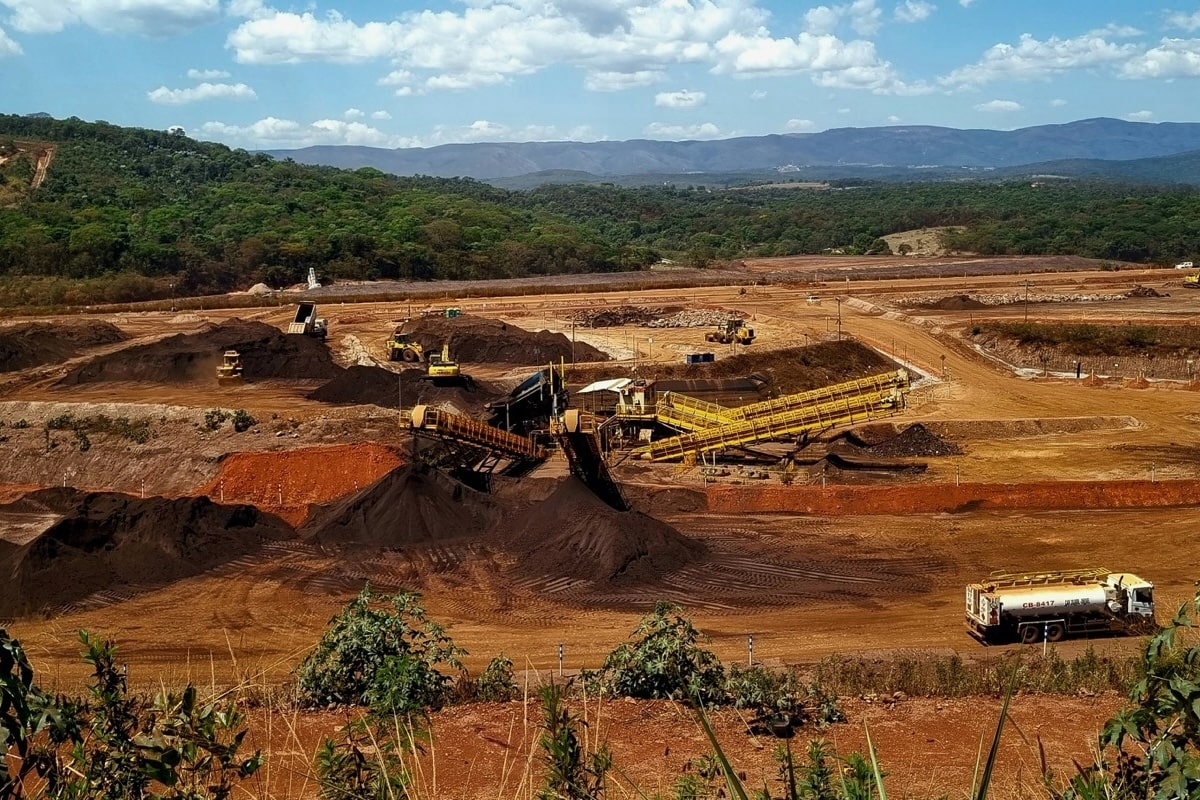While not being the most carbon-intensive production in the world, gold mining is still responsible for around 0.3% of annual global emissions. The transition to net zero is challenging due to the nature of the complex mining process and other factors, but it also may be truly rewarding if all opportunities are considered.

Gold & Sustainability
Compared to some fast fashion items that take a great deal of resources to end up in a landfill in a couple of seasons, gold jewellery seems like a pretty sustainable item. It can be literally stored for ages and almost never loses its value. In fact, gold typically appreciates over years. Besides, being too valuable to throw away, gold normally gets a second life. It rarely stops on the second one, frankly, since the material can be melted down and reshaped into something new over and over without any quality loss.
On the other hand, gold mining itself involves extracting ore from the earth, which is an energy-intensive process. The ore processing typically involves techniques like cyanidation or roasting, both requiring significant energy. Another major source of carbon emissions in gold mining is heavy machinery used for extraction and logistic purposes, such as trucks, excavators, and drills, which often run on diesel. Improper disposal of mining waste might also release methane, a potent greenhouse gas. Besides, many mining operations are in remote areas without access to the grid, relying on diesel generators for electricity.
In addition, mining often requires clearing large areas of land, leading to deforestation and loss of carbon sinks. Today, gold mining is growing in emerging economies, e.g. in many African countries, with new mine sites emerging and the existing ones expanding. Although it does provide employment and investment opportunities to local citizens, expansion also depletes natural resources in such regions.
No one knows the exact total amount of gold ever mined, but the best guess is that around 212,582 tonnes of gold has been mined throughout history. Two-thirds of all the above-ground stock of gold has been mined between 1950 and today, estimates the World Gold Council. Each year, mining operations extract about 2,500 to 3,000 additional tonnes of gold. Estimated emissions for the global gold market are currently around 126.4 Mt CO2 equivalent a year and 800 kg CO2 (or 0.8 carbon credit equivalency for every ounce of gold produced.

How Can the Gold Industry Achieve a Net Zero Objective?
The necessity of transition to a Net Zero economy has long been widely recognised by policy makers and investors across the world. Since sustainable investing is experiencing a significant surge today, more and more asset managers are questioning gold ESG credentials and its climate impact. The closer gold is to a net zero objective the better for all the stakeholders, even if its environmental impact does not seem that significant on a global scale.
Shift to Sustainable Energy
To eventually reach net zero, gold mining has to transition from relying on fossil-fuel-based electricity generation to alternative energy sources like solar, hydropower and wind. optimising machinery, upgrading equipment, reducing waste production, and employing advanced automation can also help minimise energy use at a mining site.
Some battery-driven mining equipment is powerful enough to replace diesel-driven options. Thus, many mining companies are shifting to electric machinery. Businesses wanting to become more sustainable could also upgrade to more durable equipment that lasts longer, reducing the turnover and decreasing the resources needed.
Moreover, it is possible to implement systems to capture and reuse waste heat from ore processing operations, reducing the need for additional energy input at the mining site. Smart grid systems along with energy storage solutions, like large-scale batteries, help manage energy distribution efficiently across mining sites, reducing wastage.
Finally, one can purchase renewable energy through power purchase agreements (PPAs) to ensure that electricity used in mining operations is sourced from renewable resources.
Leverage Biology
Scientists are also actively exploring biological methods of metal extraction, like bio-mining and phytomining. Those use living organisms (e.g. prokaryotes, fungi and plants) to extract metals from ores and other solid materials. They reduce damage to the environment, but at the same time significantly decrease the speed of the metal extraction process. Therefore, some compromise is yet to be found on the topic.
Gold phytomining can be applied to mineralised soils and gold mining waste. If processing costs can decrease and scientists manage to reach a higher concentration of gold in the plants, phytomining may prove an economically attractive niche market technology to mine gold from certain ore-rich areas without destroying natural habitats.
Wise Waste and Water Management
The disposal of gold mining waste, including tailings, is not exactly sustainable today. Ore processing involves crushing the extracted rocks into sand to recover the gold. Leftovers are called tailings. Improving the management of tailings by dry stacking or reprocessing used to extract remaining minerals can reduce the environmental footprint of the mining altogether. Moreover, organic waste generated during mining operations can be turned into bioenergy, further used to power certain processes.
Apart from that, the contaminants in gold mine tailings may be dispersed into the environment by wind, rainwater runoff and surface water flow. Using more efficient water treatment technologies can prevent pollution and reduce the environmental impact of mining on local water bodies. Implementing systems to recycle water used in the mining process can reduce the need for fresh water and further minimise the impact on local water sources.

Offset Emissions and Restore Land Sites
As any other businesses, gold mining facilities that cannot fully exclude carbon emissions from their daily operations may invest in carbon offset projects, such as reforestation, afforestation, or renewable energy projects, or acquire high-quality carbon credits to cover for what cannot be eliminated through direct action.
After mining operations stop at a given site, a sustainable solution is restoring the land through revegetation or reforestation. It can help restore biodiversity and act as a carbon sink. Besides, such practices can help to enhance social acceptance of mining activities by local communities whose lives are imminently affected and establish healthy relations with local stakeholders.
Challenges and Opportunities of Making Gold Sustainable
Gold mining, which is the main source of carbon emissions in the whole gold supply chain, is a peculiar industry. Unlike many other facilities, mining sites cannot be located at any place of your choice. Gold-rich territories are often situated in the wildlife habitats negatively affected by intrusive mining activities. Some renewable energy solutions that serve other industries well may not be feasible in remote mining locations due to storage, reliability, or infrastructure challenges.
One of the main challenges on the way to net zero gold is the high upfront cost of implementing eco-friendly technologies and practices. Renewable energy sources, electrifying equipment, and implementing carbon capture technologies are expensive and smaller mining sites might not be able to afford them. Nevertheless, sustainable gold miners may access government subsidies, tax breaks, or grants for companies investing in renewable energy and other green technologies, to offset the initial costs of transitioning to net zero.
Gold mining is also subject to multiple regulations in different jurisdictions. Where the law doesn’t explicitly require responsible and sustainable mining practices, cases of pollution and habitat destruction resulting from mining activities may appear more often. Thus, robust legal frameworks are among the most important facilitators of ESG responsibility in gold mining. On the contrary, inconsistent regulations and varying levels of commitment to carbon neutrality across countries can make it difficult for mining companies to implement uniform strategies in different locations.
Benefits of Sustainable Gold Mining
Due to the history of legal battles and public outcry regarding environmental damage caused by gold mining, local communities may not welcome another gold mine in the region. Being transparent about ESG commitments and carbon neutrality goals helps gold mining companies gain support from investors and local stakeholders.
Developing and implementing responsible mine closure and land rehabilitation plans can ensure that the ecosystem will be restored to its original or even better state and there still will be forests to absorb the carbon naturally.
Moreover, shifting to cleaner energy sources at a particular mine site can have beneficial impacts beyond decarbonising the ore extraction itself. For many remote locations, bringing clean power to mining means also supplying rural communities that would not otherwise have access to it with sustainable energy.
If treated responsibly, gold mining will also bring significant economic benefits to local communities. It provides better “green” employment chances, infrastructure development, and tax revenues filling the local budget. As consumer demand for ethically sourced and environmentally friendly gold is rising, affected communities face less risks connected to mining and more opportunities.
Furthermore, gold might become an even more desirable asset for those investors seeking to decarbonise their portfolios, if it becomes carbon neutral. Today, institutional investors are trying to ensure their investment holdings are more resilient to climate risks, considering the carbon profile and decarbonisation potential of their assets. Reaching a net zero goal adds more value to gold as a safety net, reducing its vulnerability to not only geopolitical events but also climate-related shocks and losses.
Transitioning to net-zero emissions in gold mining can potentially lower costs in the long term, although the upfront investment in innovative technologies might be costly. It enables more efficient use of resources and overall operational processes. Implementing circular economy practices, such as reprocessing tailings or recovering gold from electronic waste, also gives way to new revenue streams and reduces the need for new expensive mining operations. Besides, mining companies can reduce their exposure to the volatile prices of fossil fuels, which can help stabilise operating costs.
Conclusion
To put it concisely, the energy-intensive gold mining process is one of the main pain points for gold transition to a net zero asset. Yet there are many ways to improve carbon neutrality at mining sites. They may require significant investment like most radical innovations. Nevertheless, the benefits of a shift to intrinsic sustainability are far outreaching the risks of conducting socially and environmentally irresponsible mining practices.









